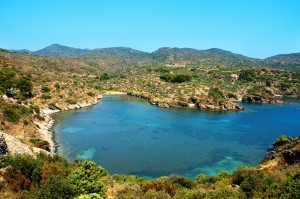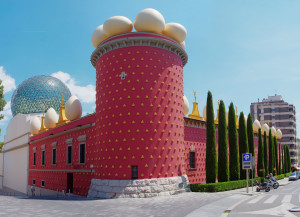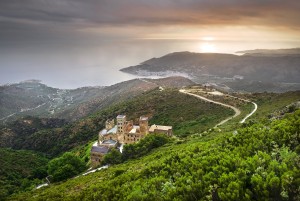Today we have a guest post from Laura Masramon. Ms. Masramon is a personal sommelier and a member of the DO Empordà Wine Route. In this first part of a two-part series, she tells us about the ancient beginnings of the Empordà DO, located on the Mediterranean Coast in Spain’s Costa Brava (Catalonia).
In the far north-eastern tip of Spain—bordering the south of France—there is a natural area formed by the end of the Pyrenees as they disappear into the Mediterranean Sea. At this point of the northern Costa Brava, known as Cap de Creus, the mountains create idyllic little creeks with crystalline, turquoise waters. Between the sea and the mountains lies the Empordà plain. Three natural parks cover much of the area.
Wine has been made in this part of the Mediterranean coast since winemaking first began. However, up until just a few decades ago, most of the wine was sold for local consumption, and Empordà wines were not known outside the region. Nowadays, all that has changed.
The Empordà is an emerging region for both its wines and its wine tourism. Every year there is a rise in the number of new vines planted and old vines recovered, in the number of new wineries and the number of tourists visiting the area that want to taste the new wines.
However, wine is not the Empordà’s only attraction. It is a dream land, a refuge for Catalans seeking inspiration. It is the land of artists like Salvador Dalí, a source of creativity and a place for resting and communing with nature. Despite attracting a large number of tourists, particularly in summer, this region has managed to preserve the beauty of its countryside in the face of urban development. It has small villages that live on tourism, farming and culture.
Greco-Roman wine culture: The origin of the word Empordà comes from the Greek village of Empúries. The archaeological remains of this village have revealed grape seeds from 2,700 years ago as well as commercial letters written on sheets of lead with orders for wine. Wine amphoras have even been found off-shore, onboard sunken ships with the cork stoppers and the wine inside them still intact.
The Romans also inhabited these lands and extended the Empordà wine trade throughout Europe, just as the emperor Marcus Aurelius Probus (232-282 AD) ordered when he said: “may the citizens plant vines and become rich”. Vine growing has always been synonymous with prosperity, culture and wealth.
Even today, a tour of Costa Brava may include a visit to the Greek and Roman ruins of Empúries, an archaeological site from over 2,000 years ago, with remains of trade and vine growing.
Monasteries, vine terraces and stone wine cellars: The Greeks and Romans left an indelible mark but their age came to an end. In the Middle Ages, local monks grew vines on the slopes of Cap de Creus, in the surroundings of the magnificent Benedictine monastery of Sant Pere de Rodes (9th-19th centuries). The cultivation of vines on these arid, stony, steep terrains was hard work but the money that they made from selling wine enabled them to be self-sufficient.
The old 17th-century wine cellar at the monastery of Sant Pere de Rodes can still be visited today.
The great wine-growing crisis gave the cork industry a boost: Just before the famous phylloxera plague crossed the Pyrenees and began devastating all the vines, Empordà wine experienced its golden age. The wine was exported to Europe and the former Spanish colonies in America. The arrival of phylloxera, in 1879, brought about the most terrible modern crisis and the villages became impoverished. In place of vines, olive trees and cork oaks were planted. Costa Brava is currently one of the most important regions in the world for the production of corks. One of the most original wine tourism offers is to see cork being collected. This activity only takes place in June and July and is available at certain wineries.
It took several generations for vines and wine production to return to the region, as we will soon see in part two of this series: The Contemporary History of Empordà Wine. Stay tuned!
About the author: Laura Masramon is Personal Sommelier and member of the DO Empordà Wine Route. She is also co-director of the wine branding seminars Marca Vi and Vivid Enoconference. For more information on Laura, see her website.
References/for more information:
Are you interested in being a guest blogger or a guest SWEbinar presenter for SWE? Click here for more information!


